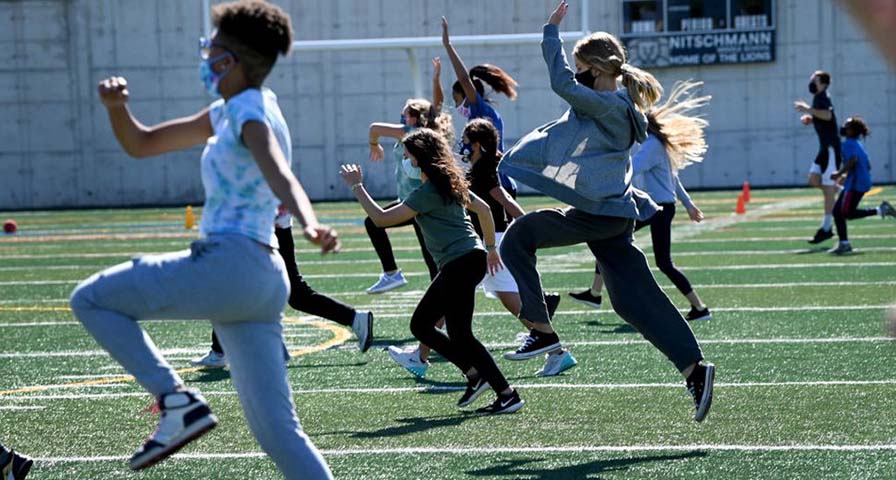Originally published June 7, 2021 by US News and World Report.
By Megan MacDonald
A hard and fast warning was just issued from the United Kingdom and it affects our children. U.S. policymakers, educators and administrators, take note. The warning: the COVID-19 pandemic has exacerbated declines in children's physical fitness, excessive weight and mental health. Action is needed.
Sadly, in the U.S., two epidemics pre-dated COVID-19: an obesity epidemic and a mental health crisis. In fact, these two epidemics have been intensified by the global health pandemic, particularly for children. Suspected childhood obesity rates are on the rise with evidence suggesting long-term negative impacts and mental health-related pediatric emergency room visits were up by 31% by the end of 2020.
In the U.S., the prevalence of childhood obesity is 18.9%; almost a fifth of our children are overweight, with disproportionately higher rates identified in vulnerable children, like those from a lower socioeconomic status and children with disabilities. Children who are obese are more likely to have poorer social emotional health, and physical activity is a known behavior to combat obesity and aid in improving mental health.
For many children, it's been a year of schooling from home. This means substantial screen time and limited physical activity. Like most teachers, physical educators pivoted in March 2020, and creatively managed to teach physical education via virtual learning environments. Their role has been critical in ensuring students are active and maintaining the learning that would have occurred in physical education for the past year. Their efforts have been nothing but exceptional and, as they know, it was always a temporary substitute for in-person learning.
Physical educators teach a range of skills including but not limited to hand-eye coordination, balance, sport-specific skills, and how to transfer learned skills to community participation, which is known to uplift social-emotional health and possibly academics. The American Academy of Pediatrics agrees that schools play a critical role in providing opportunities for childhood physical activity. Physical educators are experts at combating the childhood physical inactivity epidemic and childhood mental health crisis – both epidemics silently but surely reaching a boiling point.
Yet, trends indicate that physical education is being left out of many phase-back plans for students as the pandemic lifts. I've heard stories of limited physical education, such as only 15 minutes per week and stories like gymnasiums, the primary physical education classrooms, being repurposed in phase-back plans, often retrofitted with dividers to act as traditional classrooms. Some schools, using hybrid-style phase-back plans, have left physical education online, neglecting to consider it for in-person learning.
This practice does not align with education laws.
Equitable access to physical education is vital to embracing physical activity as a lifelong behavior. In the United States, physical education is clearly identified as a part of a well-rounded education in the Every Student Succeeds Act (ESSA). And in fact, the overarching special education law in the U.S., the Individuals with Disabilities in Education Act (IDEA), indicates that physical education is a direct service for children with disabilities. This means physical education can and should be included in every individual education plan (IEP) for children with disabilities.
I don't want to be facile about the difficult decisions teachers, administrators and districts consider as their schools return to a new normal. But undervaluing the role of physical education is inappropriate – it is a part of a well-rounded education by law and a part of a student with a disability's IEP, a legal document. To sideline trained experts in our children's physical and mental health is a problem. Furthermore, physical educators are being asked to aid the school in ways that depreciate their training. I've heard stories, for example, of PE teachers being asked to monitor hallways.
The benefits of physical activity are well-known and well-documented. They have profound lifelong health benefits, such as better cardiovascular health, stronger muscles and bones, improved mental health, and lower risk for cardiovascular disease, diabetes, metabolic syndrome, and other diseases. The American College of Sports Medicine has an initiative called Exercise is Medicine; if a dose of physical activity came in the form of a pill, everyone would take it. But physical activity is not a pill. It is a behavior that is learned, taught, practiced and reinforced. It is a behavior that is powerful for our health, education and life.
If we get it right, we can ensure a healthier future for our children that includes education about physical activity and knowledge about how it positively impacts mental health.
Our collective need for movement has never been clearer. And we don't have time to miss out on opportunities to improve the mental and physical health of our children.
Physical education needs to take priority in school phase-back plans.
In fact, the law requires it.
Megan MacDonald is an associate professor of kinesiology in the College of Public Health & Human Sciences at Oregon State University and the IMPACT for Life Faculty Scholar. She is also the director of the early childhood research core at the university's Hallie E. Ford Center for Children & Families and a public voices fellow through the OpEd Project.
Learn How the IHT Spirit System Encourages Physical Activity in School-Age Children:





